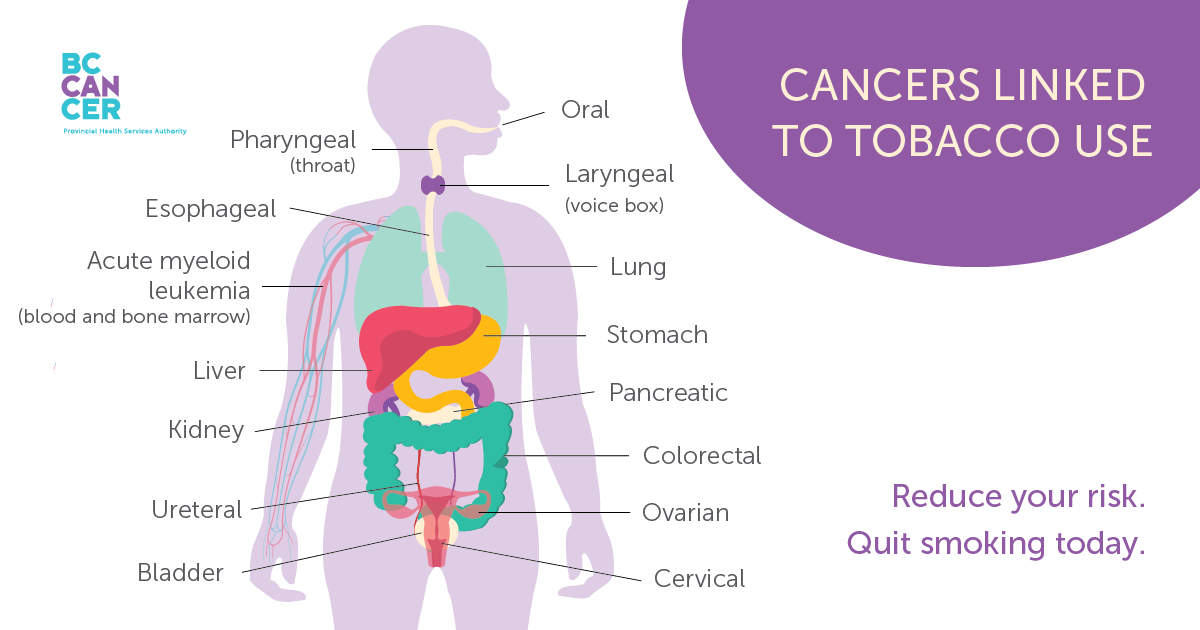Tobacco products have many chemicals that damage our DNA. This can cause cancer and other serious health problems.
Lung cancer is one of the most diagnosed cancers, and the leading cause of cancer-related deaths around the world. In B.C., seven people die of lung cancer every day, with 70 per cent of cases being diagnosed at an advanced stage.
Smoking remains the most significant cause of lung cancer, resulting in over 70 per cent of lung cancer deaths in men, and 55 per cent of lung cancers deaths in women.
Tobacco use harms nearly every organ in your body. It not only contains nicotine, which is highly addictive, but the smoke contains more than 7,000 chemicals that can make their way into your lungs, blood and organs. Hundreds are toxic and about 70 of them are linked to cancer.
Quitting smoking lowers the risk for at least 20 different types of cancers, including cancer of the lung, larynx (voice box), mouth, esophagus and bladder.

People who breathe second-hand smoke inhale the same harmful chemicals that people who smoke do, and are at risk of many of the same issues, including cancer and heart disease.
Babies and children are particularly vulnerable to the effects of second-hand smoke. They have a higher risk of developing ear infections, chest infections, frequent and severe asthma attacks and other breathing problems.
Learn more about the
benefits of quitting.
Tobacco comes in many forms and can be smoked, chewed or sniffed. Smokeless tobacco, such as loose leaf pouches, plugs or snuff, are chewed or held in place, allowing the nicotine to get into the bloodstream through the mouth.
People who use smokeless tobacco have increased risks of mouth, esophageal and pancreatic cancer as well as gum and tooth decay and mouth sores.
Heated tobacco, or heat-not-burn, products are electronic devices filled with processed tobacco leaves and other chemicals. When heated, they produce a vapour containing nicotine, which you inhale.
Electronic cigarettes (also known as e-cigarettes, vape pens, vapes and pod mods) are battery-powered devices that heat a liquid (e-juice that can contain nicotine) and turn it into a mist that is inhaled.
The long-term health consequences of vaping are not yet known.
- The second-hand mist created by "vaping" has chemicals that may harm your health. These can include nicotine, heavy metals (like lead), and other cancer-causing agents.
- Most vaping substances available for sale have flavourings that contain chemicals as well as nicotine.
People who don’t currently smoke, young people and people who are pregnant should not use vapour products and other e-cigarettes. Vaping products that contain nicotine or cannabis are unsafe for young adults, as their brains are still developing.
Visit
HealthLink BC for more information about vaping.
- Smoking is the leading cause of preventable death.
- In B.C., 27 per cent of all cancer cases are
due to smoking tobacco.
- Every year, more than 800 Canadians who don’t smoke
die from second-hand smoke.
- Over 50,000 cancer cases could be
prevented by 2042 if more Canadians quit or didn’t start smoking.
